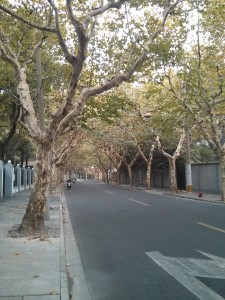Shanghai Street View: Absent Autumn

It seems that old habits die hard when you’re among the thousands of sweepers clad in signature blue smocks who work tirelessly to keep Shanghai clean. That’s the lesson I learned when I took to our city’s streets this week to check out an innovative program to enhance the autumn atmosphere in the former French Concession area.
The new program was simple and quite creative, attempting to create a feeling of fall by allowing fallen leaves to accumulate throughout the day on several tree-lined streets. Such leaves are typically cleared away by sweepers within minutes of touching the ground, keeping our streets spotless but also deprived of much local color.
But in this case, I quickly discovered the program hasn’t gained much traction due to overenthusiasm from sweepers who couldn’t bear to see their domain cluttered with autumn foliage.
Regular readers will know I have a complex relationship with our city’s legions of street sweepers, who are easily recognizable by their dark blue smock-like uniforms with florescent yellow stripes. I really do feel these people represent a broader category of worker from China’s socialist past, when simple employment was far more important than finding productive uses for workers.
Others who fall into this category include the thousands of traffic assistants who stand at street corners throughout the city, and the small army of inspectors who perform safety checks at our subway stations. These people often perform functions that either aren’t really necessary or could easily be automated, and their manpower could be much better deployed on services for less affluent groups like retirees and children of migrant families.
Despite my skepticism, I gained a new appreciation for our city’s street sweepers during this year’s Lunar New Year, when I made one of my first trips in years to spend the holiday at the home of a friend in a small town in Anhui. That town could certainly use some of Shanghai’s sweepers, as I quickly realized after seeing the garbage that was a regular fixture on most of the local streets and sidewalks.
Many younger people in big cities like Shanghai now throw their litter into roadside trashcans, but a significant group still carelessly toss their trash onto the streets. Luckily for us, those discarded cigarette boxes, soda cans and other trash seldom stay on the streets or sidewalks of Shanghai for more than a few minutes before a worker in blue comes by and quickly sweeps them away.
Against that complex background, let’s return to our main story that revolves around a pilot program in Xuhui. It called on the street sweepers to halt their activity on a few selected streets for most of the day, allowing leaves to accumulate from the sycamore trees that line those streets. Those broad-leafed trees, which were brought by Europeans in the colonial era, form the shady and scenic canopies that are one of Shanghai’s most distinctive features and allow for pleasant strolling on even the hottest summer days.
While leaves were allowed to accumulate during the day, sweepers were instructed to clear them in time for the late afternoon rush-hour to avoid causing traffic problems. The idea sounded quite nice, and I was looking forward strolling down the leafy streets when I went to Hunan Lu and the adjacent Wukang Lu to check out the program.
But when I got there, I was surprised to see the 2 streets were spotless, and sweepers were quickly disposing of fallen leaves as usual. I approached one, who explained the dilemma they were facing under the program. According to the explanation, sweepers were told to let leaves accumulate until 4 p.m. each day, but then had to quickly remove them afterwards so the streets would be clear in time for afternoon rush hour at 5.
The explanation certainly made sense, though I do suspect that many of the sweepers could easily clear up the clutter in the allotted hour between 4 and 5. Instead, I suspect that many of these people weren’t given alternative work to do during the day, and thus were probably somewhat bored. Adding to that was probably the fact that many couldn’t bear to see their spotless domains cluttered, even if it was just for a few hours by something natural like leaves.
It does seem the program could have been better executed and I’m still hopeful city officials will find a way to make it work next year. The extra work of quickly clearing streets each afternoon could easily be done by one or two street-sweeping machines, and workers who are idled by the program could be given some vacation time. At the end of the day, I can’t really fault the sweepers for their enthusiasm, though this kind of result once again highlights that their manpower could be better used elsewhere.
